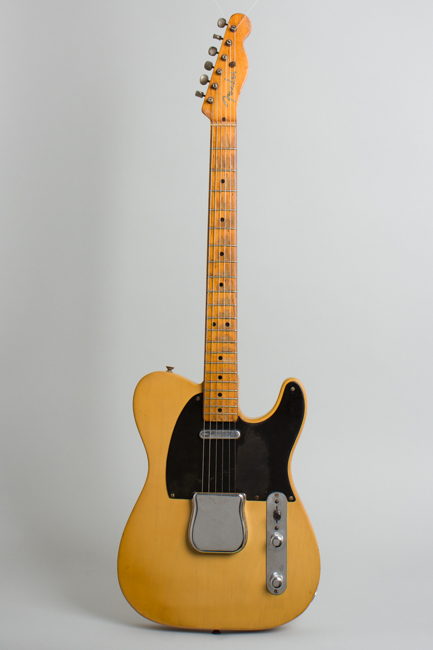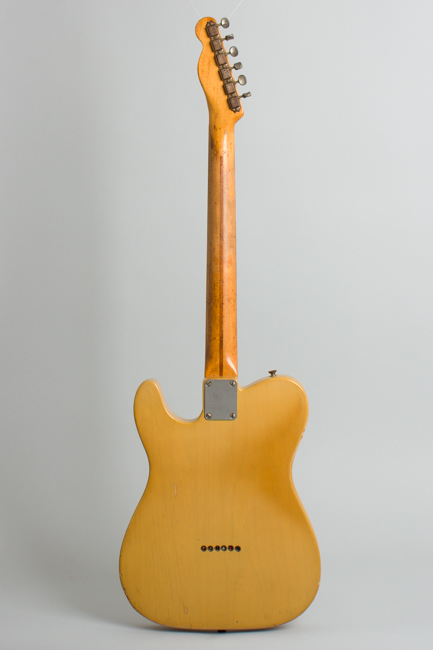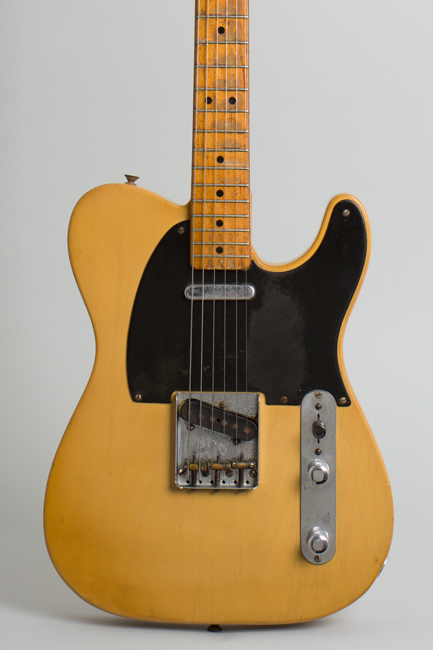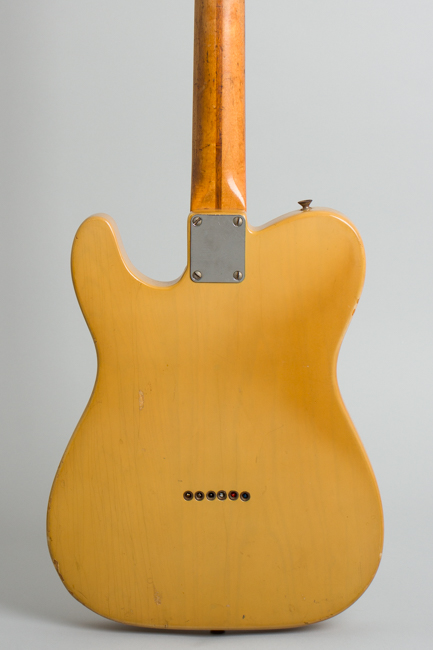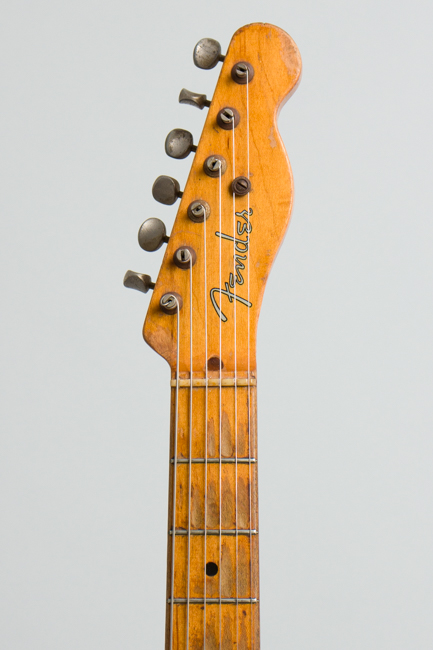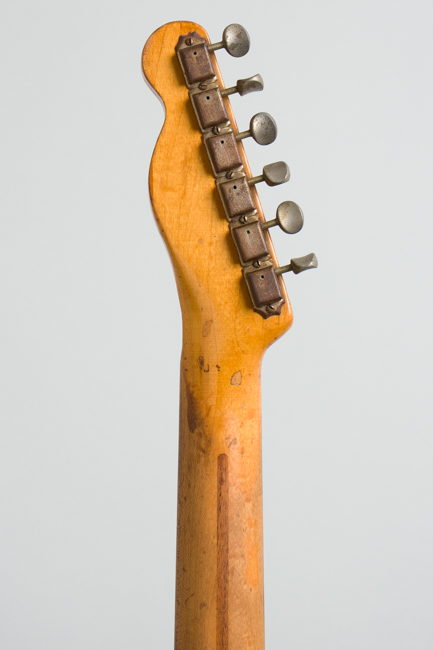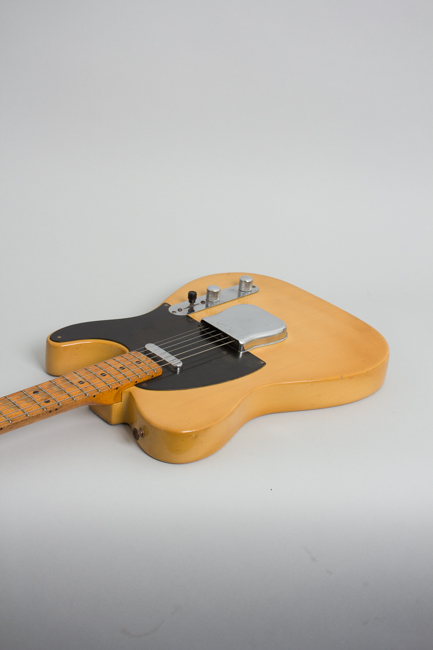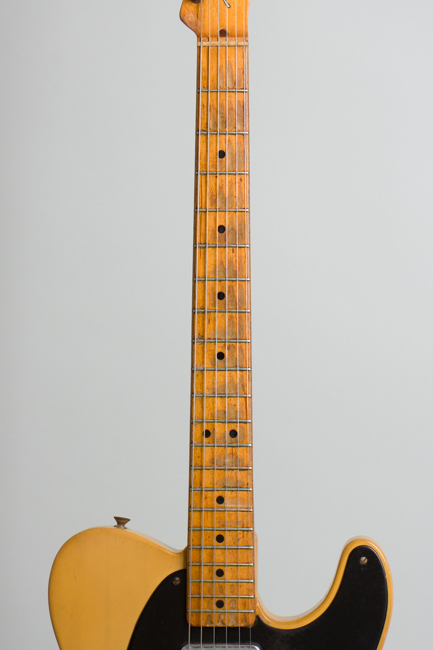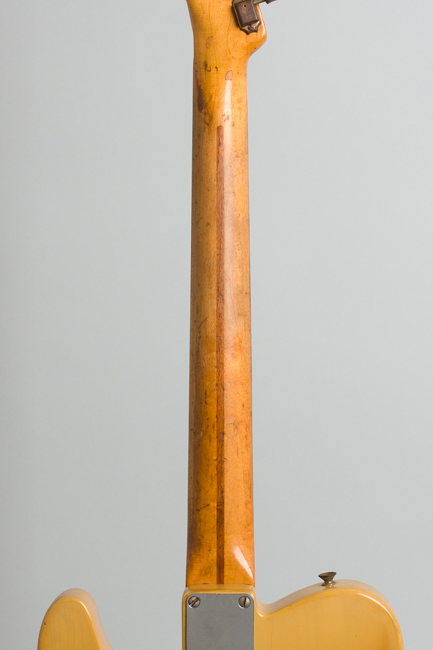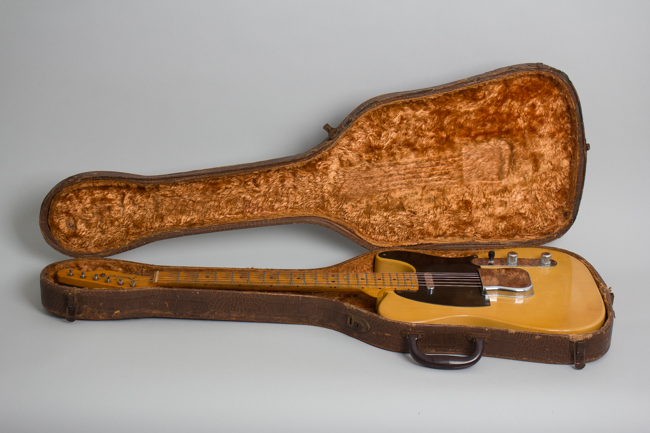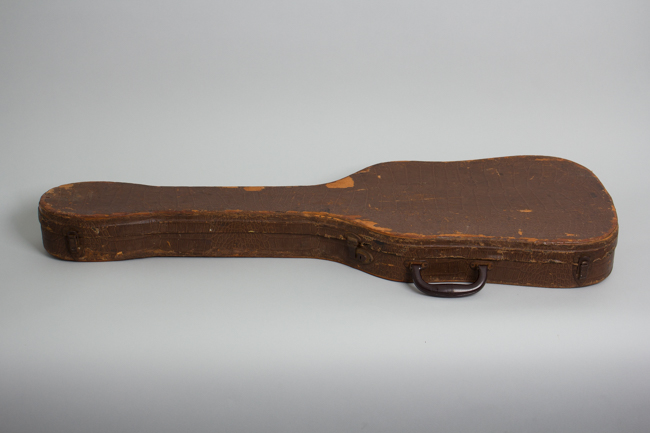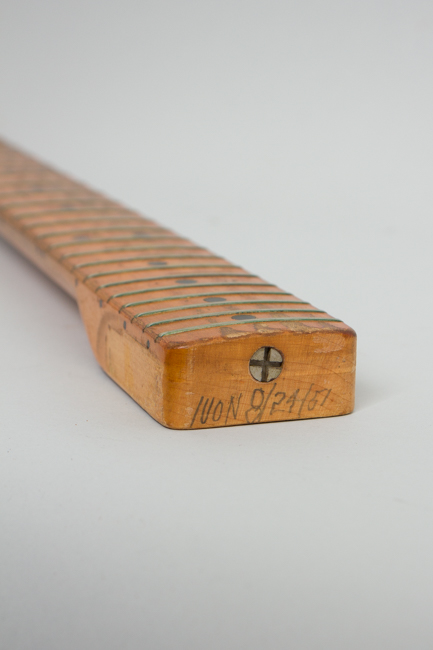Fender Nocaster Solid Body Electric Guitar (1951)
This item has been sold.
Item # 12321
Prices subject to change without notice.
Fender Nocaster Model Solid Body Electric Guitar (1951), made in Fullerton, California, serial # 1896, Blonde re- finish, ash body, maple neck, original brown shaped hard shell case.
This is a rare and historic "Blackguard", one of the last of the famous clipped decal "No-Casters" (a collectors' name, not Fender's!) made in 1951 after the "Broadcaster" name was discontinued but before "Telecaster" officially replaced it. This began after Fender received a telegram from Gretsch on February 21st 1951 claiming they held a trademark on that name. By September 1951 Fender has announced the new "Telecaster" name and the last of the clipped decals were being used up (Fender never wasted ANYTHING!). This late "Nocaster" has a very old a body-only refinish but otherwise remains original, heavily played and well worn but a magnificent instrument.
The serial number 1896 is stamped into the bridgeplate; Fender never ran the numbers in sequence but this is typical for the mid/late 1951 period. The neck date is 8-24-51 with the penciled name that appears to read "IVON" which is an idiosyncratic feature of this period. The guitar comes with a printed copy of an email from Tele expert Nacho Banos stating "Yes I've seen that before. The name of the Fender worker is Juan. I've seen his signature only on pre-'52 guitars. I don't know his last name. He signed some bodies and necks during this period. Maybe he was only temporarily hired". The neck cavity has no visible date due to the refinish, but the familiar initials "TG" can be vaguely discerned. The pot date codes are soldered over, but they are the correct Stackpole originals.
This guitar remains original except for the body finish, which is a correct butterscotch hue but noticeably thicker than the original; it appears about 40-50 years old. 1951 Fender finishes were not particularly hard-wearing, so this is fairly common. The neck finish and all parts remain original, well worn in spots but complete down to the snap-on bridge cover. All screws are slot-head except the truss rod adjustment, which had just transitioned to cross-head. Under the pickguard the body has the familiar oblong wiring rout adopted just after the "Broadcaster" name was discontinued.
While some solder joints were re-done for the refinish, the electronics remain original with the original now obscure deep bass/pickup blend wiring discontinued early in 1952. The "deep bass" capacitor acts on the neck pickup in switch position # 1, giving a dark muted sound. Position #2 is the neck pickup alone without a tone control, while the bridge pickup is similarly engaged in position #3. The two pickups can be combined by rolling down the second knob, which blends the neck pickup signal in with the bridge unit. This is a subtle but attractive sound, but the wiring could be altered to modern switching with a true tone control if desired.
The neck has a very comfortable fairly slim profile for 1951 with the slight feel of a soft "V" along the spine, which is another characteristic of this period along with the clipped decal reading just "Fender" on the headstock face. The Kluson Deluxe tuners are the first "closed shell" version, and even small parts like the milled jack cup and strap buttons have variations from later versions. At 7.11 Lbs. (with the bridge cover on) this is a relatively light and handy early Fender.
Although made in a factory environment, early 1950s Fenders were basically hand-made; this guitar retains the basic look and feel of a 1950 Broadcaster, changes primarily being the "No-Caster" headstock decal and the wiring rout under the pickguard. The one-piece maple neck, blonde-finished ash body, lacquered black fiber pickguard, brass bridge saddles, and of course the early pickups with a sound for the ages carry through the Blackguard years.
The first Fender guitars from 1950-51 have been highly sought for decades now. The fine details of the instrument continued to gradually evolve but this is where it all began, the first flowering of the Fender guitar. Even with the refinished body this is simply a fantastic instrument; it really rings even not plugged in, the lead pickup is pure twang heaven and the subtle blend wiring is a sweet variation on Tele sonics. AND it still rests in the original shaped case, a very desirable piece all by itself in the 21st century.
Overall length is 38 3/4 in. (98.4 cm.), 12 5/8 in. (32.1 cm.) wide at lower bout, and 1 3/4 in. (4.4 cm.) in depth, measured at side of rim. Scale length is 25 1/2 in. (648 mm.). Width of nut is 1 5/8 in. (41 mm.)., 7.11 lbs.
This is a beautifully weathered guitar, heavily worn but not abused with the body only refinished long ago. Even so it is still more original than many seven-decade survivors. The body likely lost its fragile original finish long ago; the instrument was redone in correct-style blonde at some point. This was a pro job, but not to a modern restoration spec. This finish has some checking, light wear and a distinctly "smoked" look. The neck finish appears completely original with a lot of wear down to the wood on the back. The maple fingerboard has heavy play wear along much of its length (this was NOT a "Cowboy Chord" guitar!) and "strum wear" at the body end. The headstock shows some finish loss but the original clipped decal is well preserved.
The lacquered black pickguard is original and shows some typical wear, notably a rubbed-down spot below the strings. The original metal hardware including the bridge, brass saddles, control plate, pickup cover, round string retainer, neck plate and screws all show typical plating wear as does the original bridge cover. The early pattern Kluson tuners show a lot of corrosion but still work as well as they ever did. Small parts including the strap buttons, jack cup and screws are original showing typical wear as well; nothing on the guitar appears to have been replaced except the bridge height screws, which simply look too clean to be period.
As noted the guitar was never re-wired to the "modern" 3-way layout with a tone control. The "blend knob" wiring, pickups and electronic components (pots, switch and wire) remain original except some solder joints re-done, as would have been done for the re-finishing. The early pattern knobs and switch tip remain original.
The small wire frets appear original, obviously having been dressed down more than once along the way. There is a surprisingly decent amount of wire left but some players would prefer a refret for playability to a more modern standard, which of course can be arranged. The bone nut is original as well. As it stands this Nocaster remains quite playable, a great sounding instrument, the epitome of the early Fender tonal aesthetic. It lives in the rare original brown shaped pasteboard case, a serious rarity in itself now 70+ years on. While not 100% original, this is still a very historic guitar with killer vibe to spare! Overall Very Good + Condition.
This is a rare and historic "Blackguard", one of the last of the famous clipped decal "No-Casters" (a collectors' name, not Fender's!) made in 1951 after the "Broadcaster" name was discontinued but before "Telecaster" officially replaced it. This began after Fender received a telegram from Gretsch on February 21st 1951 claiming they held a trademark on that name. By September 1951 Fender has announced the new "Telecaster" name and the last of the clipped decals were being used up (Fender never wasted ANYTHING!). This late "Nocaster" has a very old a body-only refinish but otherwise remains original, heavily played and well worn but a magnificent instrument.
The serial number 1896 is stamped into the bridgeplate; Fender never ran the numbers in sequence but this is typical for the mid/late 1951 period. The neck date is 8-24-51 with the penciled name that appears to read "IVON" which is an idiosyncratic feature of this period. The guitar comes with a printed copy of an email from Tele expert Nacho Banos stating "Yes I've seen that before. The name of the Fender worker is Juan. I've seen his signature only on pre-'52 guitars. I don't know his last name. He signed some bodies and necks during this period. Maybe he was only temporarily hired". The neck cavity has no visible date due to the refinish, but the familiar initials "TG" can be vaguely discerned. The pot date codes are soldered over, but they are the correct Stackpole originals.
This guitar remains original except for the body finish, which is a correct butterscotch hue but noticeably thicker than the original; it appears about 40-50 years old. 1951 Fender finishes were not particularly hard-wearing, so this is fairly common. The neck finish and all parts remain original, well worn in spots but complete down to the snap-on bridge cover. All screws are slot-head except the truss rod adjustment, which had just transitioned to cross-head. Under the pickguard the body has the familiar oblong wiring rout adopted just after the "Broadcaster" name was discontinued.
While some solder joints were re-done for the refinish, the electronics remain original with the original now obscure deep bass/pickup blend wiring discontinued early in 1952. The "deep bass" capacitor acts on the neck pickup in switch position # 1, giving a dark muted sound. Position #2 is the neck pickup alone without a tone control, while the bridge pickup is similarly engaged in position #3. The two pickups can be combined by rolling down the second knob, which blends the neck pickup signal in with the bridge unit. This is a subtle but attractive sound, but the wiring could be altered to modern switching with a true tone control if desired.
The neck has a very comfortable fairly slim profile for 1951 with the slight feel of a soft "V" along the spine, which is another characteristic of this period along with the clipped decal reading just "Fender" on the headstock face. The Kluson Deluxe tuners are the first "closed shell" version, and even small parts like the milled jack cup and strap buttons have variations from later versions. At 7.11 Lbs. (with the bridge cover on) this is a relatively light and handy early Fender.
Although made in a factory environment, early 1950s Fenders were basically hand-made; this guitar retains the basic look and feel of a 1950 Broadcaster, changes primarily being the "No-Caster" headstock decal and the wiring rout under the pickguard. The one-piece maple neck, blonde-finished ash body, lacquered black fiber pickguard, brass bridge saddles, and of course the early pickups with a sound for the ages carry through the Blackguard years.
The first Fender guitars from 1950-51 have been highly sought for decades now. The fine details of the instrument continued to gradually evolve but this is where it all began, the first flowering of the Fender guitar. Even with the refinished body this is simply a fantastic instrument; it really rings even not plugged in, the lead pickup is pure twang heaven and the subtle blend wiring is a sweet variation on Tele sonics. AND it still rests in the original shaped case, a very desirable piece all by itself in the 21st century.
Overall length is 38 3/4 in. (98.4 cm.), 12 5/8 in. (32.1 cm.) wide at lower bout, and 1 3/4 in. (4.4 cm.) in depth, measured at side of rim. Scale length is 25 1/2 in. (648 mm.). Width of nut is 1 5/8 in. (41 mm.)., 7.11 lbs.
This is a beautifully weathered guitar, heavily worn but not abused with the body only refinished long ago. Even so it is still more original than many seven-decade survivors. The body likely lost its fragile original finish long ago; the instrument was redone in correct-style blonde at some point. This was a pro job, but not to a modern restoration spec. This finish has some checking, light wear and a distinctly "smoked" look. The neck finish appears completely original with a lot of wear down to the wood on the back. The maple fingerboard has heavy play wear along much of its length (this was NOT a "Cowboy Chord" guitar!) and "strum wear" at the body end. The headstock shows some finish loss but the original clipped decal is well preserved.
The lacquered black pickguard is original and shows some typical wear, notably a rubbed-down spot below the strings. The original metal hardware including the bridge, brass saddles, control plate, pickup cover, round string retainer, neck plate and screws all show typical plating wear as does the original bridge cover. The early pattern Kluson tuners show a lot of corrosion but still work as well as they ever did. Small parts including the strap buttons, jack cup and screws are original showing typical wear as well; nothing on the guitar appears to have been replaced except the bridge height screws, which simply look too clean to be period.
As noted the guitar was never re-wired to the "modern" 3-way layout with a tone control. The "blend knob" wiring, pickups and electronic components (pots, switch and wire) remain original except some solder joints re-done, as would have been done for the re-finishing. The early pattern knobs and switch tip remain original.
The small wire frets appear original, obviously having been dressed down more than once along the way. There is a surprisingly decent amount of wire left but some players would prefer a refret for playability to a more modern standard, which of course can be arranged. The bone nut is original as well. As it stands this Nocaster remains quite playable, a great sounding instrument, the epitome of the early Fender tonal aesthetic. It lives in the rare original brown shaped pasteboard case, a serious rarity in itself now 70+ years on. While not 100% original, this is still a very historic guitar with killer vibe to spare! Overall Very Good + Condition.
